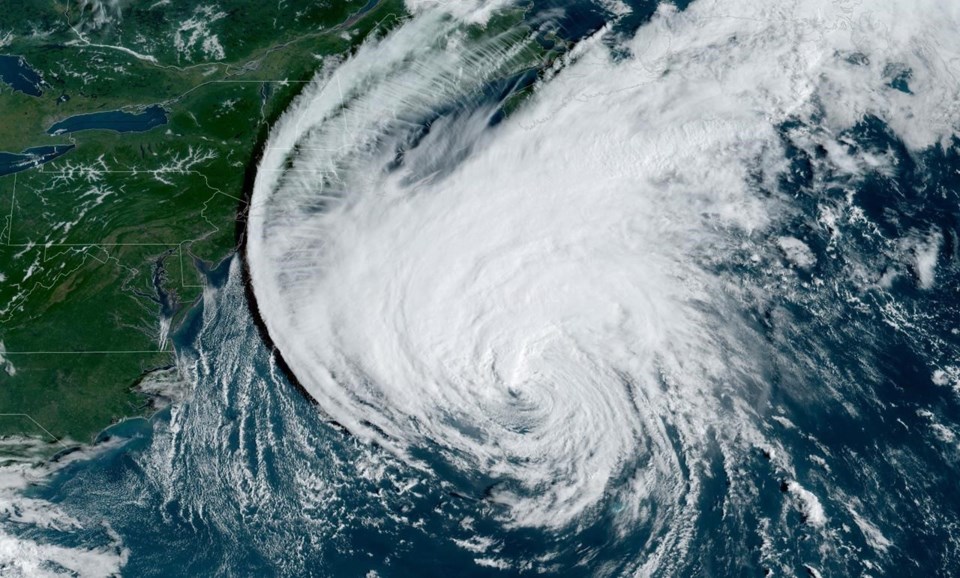HALIFAX — Donnie Fletcher can't comprehend why his small community doesn't have quality cellular service so that locals can be warned of oncoming danger, as another hurricane bears down on the Maritimes.
The 74-year-old lives in New Salem, N.S., a hamlet on a peninsula that juts into the Bay of Fundy — which is in the path of hurricane Lee, forecast to sweep through overnight on Saturday.
"Here we are in 2023 and, no cell coverage .... We're just the last place on the list it seems in terms of getting anything done," he said in an interview Thursday.
There are many potential risks in his area that could trigger an emergency alert to appear on his phone. For example, in nearby West Advocate Harbour, N.S., emergency management officials are concerned a hurricane-driven tidal surge could spill over a dike and seawall.
Steve Wood, the emergency management coordinator for Cumberland County, which includes Advocate Harbour, says he worries residents won't receive his alerts.
"The problem is, especially down in the Advocate areas, cell service is not great … It's hit and miss sometimes," he said in a recent interview.
Poor rural cell service drew public criticism — and promises by politicians to fix the problem — during the July 21-22 flash flooding in Nova Scotia, when the downpour of more than 250 millimetres of rain in a few hours resulted in four deaths.
Chrystia Freeland, the deputy prime minister, toured damaged areas and promised to deliver the criticisms to the national telecommunication regulator and federal Industry Minister François-Philippe Champagne. "It is really unacceptable for people not to be able to get emergency alerts," she said.
Yet, according to a Nova Scotia government source, about 21,000 residents still can't access high-speed cellular coverage. That number doesn't account for those who lose power as they drive through an area with little or no service.
Bell, which has the largest cell network in Atlantic Canada, estimates about three per cent of the region's residents don't have access to its long-term evolution — or LTE — network, a fourth generation wireless standard that delivers high-speed internet service. In Newfoundland, it was about six per cent as of 2021, the company says.
Paul Ralph, a professor of computer science at Dalhousie University, said governments should force telecom companies to build stronger networks. Ottawa, he added, must recognize that cellular networks are critical infrastructure — like hospitals, roads, and drinking water systems, and "therefore it should be run by the government, not by a handful of telecom oligarchs."
When hurricanes knock out power, demand for cellular data shoots up because wireless internet stops working once electricity runs out, he said. "Meanwhile … the microwave towers are running on backup batteries, and during prolonged outages, the batteries run down, and the towers go off-line," he explained.
The federal government, he said, should ensure telecom companies have enough excess capacity to keep the 911 system running during an emergency — "and in extreme situations, shut down all non-emergency network traffic."
"Alternatively, the government could require the telecom companies to install more capacity and backup generators at all the microwave towers, or to keep emergency mobile microwave towers in all major centres, which could be deployed as needed."
Geoff Moore, the network director in the Atlantic region for Bell Aliant, said in an interview Thursday that significant progress has been made since the widespread cellular coverage outages from post-tropical storm Fiona in September 2022.
Bell has invested $10 million to install an additional 100 fixed generators to major cell towers across Atlantic Canada, and about 63 per cent are now equipped with backups in case of outages, Moore said, adding that the company has 50 portable generators that can be towed to a site that's lost power and is without a generator in the region.
In addition, he said, lessons have been learned from the last hurricane: the company must ensure it has sufficient sources of diesel fuel to keep generators running.
"We're very eager to work with governments to grow the (cellular coverage) footprints," he said.
Spokeswomen for Eastlink and Rogers provided emailed statements to Bell's position, indicating that work has been underway since Fiona to improve backup systems for its cell networks.
Still, on Thursday, Nova Scotia Premier Tim Houston said he recognized that while the province has made progress on high-speed internet coverage, there’s “a lot of work to do on the cellular," adding, "we understand that in 2023 people have a right to expect cell service."
He said Build Nova Scotia — the Crown corporation that plans and builds critical infrastructure — is hiring consultants to find short-term solutions and to study how to provide widespread cell coverage, either by upgrading existing towers or building new ones.
The CRTC sent an email saying that through its Broadband Fund, the telecom regulator invests in the improvement of cellphone network coverage, adding it is "continuing to monitor and support network investment" to ensure access to public alerts.
But for Fletcher, the pace of change has been too slow, given the risks he and other rural residents are facing from climate disasters.
"I was in communication for 27 years in the military and I just can't believe the lack of coverage (of cell) in this day and age," he said.
This report by The Canadian Press was first published Sept. 15, 2023.
Michael Tutton and Hina Alam, The Canadian Press



